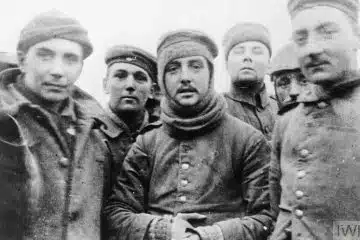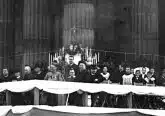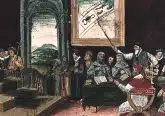Coming to America!

Immigration refers to people entering a country to become permanent residents, and emigration refers to people leaving their current country to become permanent residents in another. Genealogists benefit because ship passenger lists usually record these movements, and naturalization, the legal process by which an immigrant becomes a country’s citizen, also creates records.
Consider the following local and world events that prompted people’s movement into the U.S.—and the records they left us.
Colonial Era: When the 13 colonies were part of the British Empire, immigrants coming to them from outside Great Britain needed to state their allegiance, which created a Certificate of Communion, Letter of Denization and an Oath of Allegiance.
Pre-1820: Most immigrants to America were English and Welsh, and they settled in small clusters in the eastern, mid-Atlantic and southern states. Ship passenger lists during this time included names and departure and arrival details, although wives and children’s names were often not included.
1820-1880: Many immigrants came to America from northern Europe, the British Isles and Scandinavia, and most migrated to the Midwest and West. The 1840s-1850s saw significantly more immigrants from Germany and Ireland. Customs passenger lists asked each immigrant’s name, age, sex, occupation and country of origin but not the city or town.
Famine and religious freedom were primary reasons people emigrated during this era. Many immigrants brought their Catholic faith, which led to a Catholic community in the new nation. Notable Catholic events in Ohio during this era include: (1829) Athenaeum established and The Sisters of Charity arrived to serve in schools, healthcare and a new girl’s orphanage; (1831) The Catholic Telegraph founded, which defended the faith and continues to publish today; (1833) Bishop John B. Purcell built orphanages, hospitals and more than 100 parishes and schools; (1837) Emmanuel Church, Dayton’s first Catholic Church, founded; (1844) Congregation of the Precious Blood grew to serve the parishes and schools in Auglaize, Mercer and Shelby counties; (1850) Diocese of Cincinnati became an Archdiocese; (1852) The Sisters of Charity founded St. John’s Hotel for invalids, which grew into our current Good Samaritan Hospital; (1859) the Franciscan Fathers arrived and established a seminary and schools; the Franciscan Sisters of the Poor founded St. Mary’s Hospital.
1880-1920: Immigrants arrived primarily from southern and eastern Europe, such as Germany and Italy. Passenger list questions asked whether the immigrant was a polygamist or had been in prison, a poor house, or an institution for the insane.
Questions added in 1906-1907 asked the person’s physical description, place of birth and closest living relative in their country of origin.
1790-1905: The first Naturalization Act required terms of residency and a standard three-step process for filing. Each free, white male immigrant had to obtain a declaration of intention (first papers), an application or petition (second papers) and a Certification of Naturalization. The 1868 passage of the 14th Amendment (“…all persons born in or naturalized by the United States and of the State wherein they reside”) nullified the previous law that African Americans were not, and could not, become citizens.
1894: The declaration of intention requirement was waived for aliens who received honorable discharges after serving five years in the U.S. military.
1900 to 1950 census: The naturalization status column recorded one of three abbreviations: Na = Naturalized; Pa = First papers filed; and Al = Alien (has not begun the process).
1906: The Naturalization Act of 1906 standardized the naturalization forms, and new laws were passed during World War II.
Additional events affecting U.S. citizenship records are:
1922: A married woman’s citizenship became independent of her husband’s status.
1924: American Indians were granted full citizenship.
1943: Asian immigrants were allowed to become citizens.
The National Archives (NARA) contains immigration records for arrivals to the U.S. between 1820 and 1982. The U.S. Citizenship and Immigration Service (USCIS) currently offers an index search and the ability to request records at uscis.gov. For a fee, The USCIS Genealogy Program provides researchers access to historical immigration and naturalization records for the deceased (proof of death is required to access records of those born less than 100 years ago). Post-1906 naturalization records (limited to pre-1946) may be found on Ancestry.com, FamilySearch.org and Fold3.com
As you can see, immigrant records offer genealogists a wealth of information!
NEXT UP: Military Records
 Ruthy Trusler is a communication consultant with a passion for genealogy. For over 20 years, she has helped families document their ancestry and write their family legacies.
Ruthy Trusler is a communication consultant with a passion for genealogy. For over 20 years, she has helped families document their ancestry and write their family legacies.
This article appeared in the October 2024 edition of The Catholic Telegraph Magazine. For your complimentary subscription, click here.













